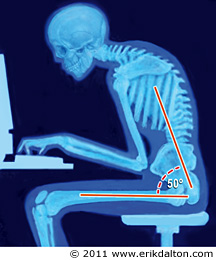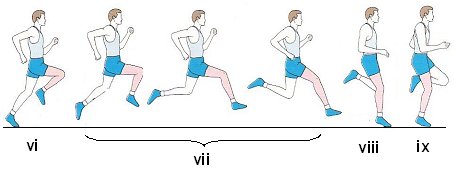Is Your Running Form The Cause of Your Pain?
When I sit down and talk with someone about their running related pain I try to cover all the bases within my scope of practice. If I need to refer you to someone who can better help you, I will. But many times it's just a matter of doing a little detective work. Most of the time a running injury will be rooted in a training mistake or some sort of biomechanical problem.
We'll talk about training mistakes like increasing mileage too quickly or adding too much hills or speed in an upcoming post, but this week I'd like to focus on the biomechanical aspect of running. If you haven't changed anything in your training for the last 6-8 weeks, perhaps we need to examine the way you move.
After ruling out training mistakes and health issues I turn my attention to those aforementioned biomechanical issues. I conduct this part of my assessment session in a specific order. First I'll screen your movement patterns looking for a weak link. Then because running requires certain mobility and stability traits, I'll narrow my focus and examine those. Finally, we'll analyze your running form with my high speed video camera.
Now, watching yourself run in slow motion can be fun and extremely helpful, but many times it's not truly necessary. It's nice to have the visual aid and show my client what is happening, but if you try to change your form based on video analysis you're barking up the wrong tree.
In actuality, it's how you show up for the run that matters.
Running is a higher order activity. Before you could run, you had to roll, crawl, creep, and walk. What I'm saying is that you had to progress towards running. You had to earn it.
But what if there are holes in that progression? If you missed some algebra lessons and earned C's, how did you fare when you studied calculus? Probably not very well-- because your foundation was full of holes!
For some, your running pain was always going to occur. It was just a matter of time. You ran for years and no pain? That's a testament to the amazing capacity of your body's ability to compensate. Eventually these compensations cause enough stress and microtrauma that you feel it. I see this a lot with people who complain about knee pain.
While your running form could very likely improve, if you are training on a dysfunctional ability to move correctly, you're bound to have problems. How will you correct your running form if your problem is that your core timing is slow or you fail to properly stabilize your pelvis during the stance phase of the running stride?
The answer is that attempting to change your running form will likely cause another set of problems because your running form is a product of your fundamental movement ability. Move better first, THEN work on your form.
For example, work on improving your ability to stand on one leg and draw your name with the unweighted foot. This *shouldn't* be a problem on your first attempt. If you're falling all over the place, consider the ramifications for a higher order activity like running- which is a dynamic series of one leg hops. If ya can't even stand on one leg quietly, fix that before you worry about your run form!
Maybe you've lost some hip mobility. So how are you getting your leg behind you when you're running fast? Most likely by giving up stability in your lower back. Now you're arching your lower back excessively with each stride instead of using your hips. Unfortunately, your lower back isn't meant to do that- plus your lower back can't provide you with any power when compared with your glute muscles.
With some of my clients who exhibit poor stability or motor control while performing a basic movement like an in-line lunge, we may take a trip back in time and practice rolling and other developmental postures like “quadruped” (on all fours) and tall- and half-kneeling. Master them and progress to standing. We're just going back and re-learning some of that developmental stuff that eroded over the years.
Maybe it's an old injury or a seated lifestyle that caused the erosion, but no matter. The good news is that you learned it once and you can learn it again. My job is to provide you with an opportunity to experience proper movement. An opportunity to FEEL the correct way.
From this point forward you now know that it is how you arrive to the workout that counts. Show up with lousy mobility or an inability to stabilize yourself and it's only a matter of time before your body starts to let you know.
And if that does happen, listen to your body!


